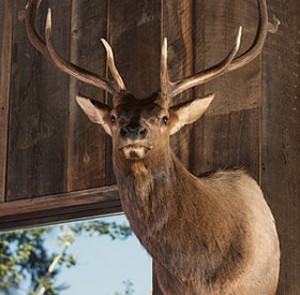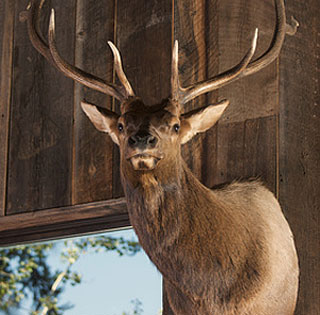Mammals are among the easiest subjects for novice taxidermists to learn. Unlike birds or fish, they don’t require any additional steps
to keep their skins looking realistic, and don’t need to be painted after mounting. However, the term “mammals” is very broad, so it’s important for a beginner to decide exactly what kind of animal they wish to work with first.
Creating a taxidermy mount of a mammal consists of a few steps, regardless of species. First, the animal should be skinned, the eyes removed, and the hide cleaned of muscle tissue. Then, the skin needs to be preserved. After this takes place, this preserved skin can be stretched over a prepared mannequin made of polyurethane foam. Since these mannequins are made from designs sculpted by wildlife artists, they allow even someone with very little knowledge of how to mount an animal hide to create a professional-looking, realistic piece.
 For the absolute beginner, getting a taxidermy kit is probably the easiest way to learn on one‘s own. These kits come with guides in book or video form that go through every step, from skinning to mounting, and can be an invaluable help to a beginner who doesn’t have the benefit of an experienced taxidermist to learn from. Videos, in particular, are helpful because they can be set up as the taxidermist is beginning the project, and stopped, rewound, or restarted as necessary. Unfortunately, most kits are fairy specific to what animal they are appropriate for, and those that aren’t will still require purchasing the right mannequin and eyes to create a finished project. Most hobbyists, particularly those new to taxidermy, don’t have the money or space to invest in keeping a wide range of mammal mannequin’s on-hand. Therefore, knowing what species, age, and even gender of mammal that is going to be worked with can be a big help when it comes time to pick out supplies.
For the absolute beginner, getting a taxidermy kit is probably the easiest way to learn on one‘s own. These kits come with guides in book or video form that go through every step, from skinning to mounting, and can be an invaluable help to a beginner who doesn’t have the benefit of an experienced taxidermist to learn from. Videos, in particular, are helpful because they can be set up as the taxidermist is beginning the project, and stopped, rewound, or restarted as necessary. Unfortunately, most kits are fairy specific to what animal they are appropriate for, and those that aren’t will still require purchasing the right mannequin and eyes to create a finished project. Most hobbyists, particularly those new to taxidermy, don’t have the money or space to invest in keeping a wide range of mammal mannequin’s on-hand. Therefore, knowing what species, age, and even gender of mammal that is going to be worked with can be a big help when it comes time to pick out supplies.
After the specimen, any supplies, mannequins, and glass eyes have been obtained, the only thing left between a new taxidermy hobbyist and an accomplished taxidermist is patience, time, and practice. Online forums exist for fans of taxidermy, and their expertise can come in very handy for the absolute beginner wondering which animal is best to start with. Best of all, forums can also afford new hobbyists a place to show their finished mounts, get critiques on their technique, and learn how to continue to improve their craft for the future.
Learning taxidermy on mammals might be a bit easier than learning on birds, reptiles, or fish, but the results are no less impressive. With the proper kit, and a bit of instruction and guidance from either professional guides, or other helpful taxidermy hobbyists, even a neophyte can learn to create taxidermy art in no time.

